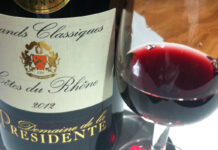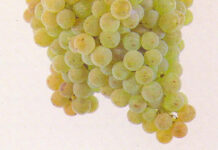Luke Richardson is the sommelier at wine bar Le Di-Vin in Edinburgh. In his column for SLTN he shares his thoughts on all things wine-related and answers your questions about wine. If you have a question for Luke email it to sltn@peeblesmedia.com

HELLO again!
I thought that this time around I would have a look at the mysterious Syrah, or Shiraz, grape. I say mysterious as nobody is really sure what it is called or where it came from originally, but in all likelihood it was probably south eastern France, namely the Rhône valley, which today is its spiritual home… if grapes have spirits!
The other option is that it came from Shiraz, the ancient capital of Persia, or modern day Iran, but this is more unlikely as there is no documentary evidence to prove it. Either way, Shiraz and Syrah are one in the same grape and, more than likely, originated around the area of the Rhône valley in France. As this grape is grown widely throughout the world in two widely different styles, I‘m going to split this in two parts, European (or Old World) first, then New World next time.
So, starting in France, in Rhône, Syrah is responsible for some of the highest quality red wines in all of France, outside of Bordeaux and Burgundy – Hermitage, Cote Rotie, Cornas and Crozes-Hermitage. These are powerful, age-worthy wines, most of them in excess of £30 in cost for a good example, with the exception of Crozes-Hermitage, which can be found for around £10 plus VAT and up.
By law, Crozes-Hermitage can be made up of only 85% Syrah, and up to 15% of either Roussanne or Marsanne (two white grapes prominent in northern Rhône), but the better ones tend to be 100% Syrah. They are silky but powerful red wines, comfortably cutting through hearty stews or fine lamb, coping easily with dry, strong, hard cheeses or dense, rich charcuterie with a fine but strong tannin structure and a decent length on the palate.
Flavour profiles range from bright red berry and silky blackcurrant fruit stretched over a mineral core with a dash of white pepper on the finish to more blackcurrant-laden, slightly jammier fruit in the lesser examples. Look for three years bottle age if possible.
Elsewhere in France, Syrah is grown in the Languedoc-Roussillon where there are some fairly decent 100% Syrahs about for around £6.50 plus VAT, showing more purple fruit and often with a herbal kick to them; but for that money I would recommend looking for Syrah/Grenache blends – two grapes that naturally complement one another.
Elsewhere in Europe, Italy grows some good Syrah, blending it with local grape varieties like Sangiovese in Tuscany, where it brings a smooth darker fruit element to the wines, and making some varietal wines too – pulling more soft velvety fruit out of the grape than you would find in France.
For the Tuscan wines you might need your cheque-book, but you can find a decent 100% Syrah for around £9 plus VAT. More often than not, though, it is grown as a pet project of a winemaker, meaning that it can be hard to find and the volumes available can be small.
Next time, The New World! Cheers!
























